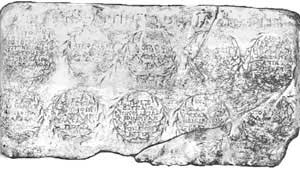
Decree honoring Diophantos
Inscription honoring the emperor Zeno
Civic Oath of Chersonesos
Decree honoring Syriskos the historian
Base of statue for Agasikles
Proxeny decree for an ambassador from Mithridates Eupator
Decree honoring ambassadors from Herakleia
Base of statue for Aristonos
Treaty of alliance with the king Pharnakes I
List of those who won sport competitions
Inscription about the tax on prostitution
Fragment of a decree about the fortress of Napites
Inscription about construction of a city gate
Dedication to the goddess Nemesis
Inscription regarding the liberation of Kalos Limen
Decree honoring the emperor Marcus Aurelius
Decree honoring Gaius Julius Satyrus
Proxeny for a citizen of Sinope
Epitaph in verse on stele for Xanthos
Inscription on the stele set up by doctor
Epitaph in verse on stele for Oinanthe
Short epitaphs
Originally published by Latyshev; commentary by Solomonik

This marble statue base was found in 1881 in the area around the main city street and dated approximately to the mid-2nd century (A.D. 131 - 154).
Text:
"(Monument for) Aristonos son of Attinos, a friend of fatherland.
Who had been an ambassador to divine Augustus (to petition) for freedom, for six years, and was exhausted.
Who executed the office of prodikos.
Who executed the office of nomophylax.
Who executed the office of damiourgos beautifully.
Who was an ambassador to the king Roemetalkes and was successful.
Who executed the office of priest beautifully (and the people awarded him with a wreath) and copper image.
Who managed the (state) treasury and elucidated the funds for the city.
Who was an ambassador to the king Roemetalkes again and was successful.
Who executed the office of damiourgos beautifully (and the people awarded him with a wreath) and a statue in full.
Who was a beautiful citizen.
- Ktesiphontos has executed"
Commentary:
This inscription honored Aristonos, who held several posts and successfully executed the city's commissions during the embassies to the Roman emperor Antoninus Pius and the Bosporan king Roemetalkes. The name of sculptor, Ktesiphontos, is indicated in the end of the inscription.
Damiourgos was an official of a high rank. His position within the structure of the government of Chersonesos are not quite clear, the same as his functions, though it evidently was a political type office.
Nomophylakes were the officials responsible for keeping documents of state and supervised over the people's assemblies and meetings of the council. Their functions might also be similar with that of present court officers: British bailiffs and U.S. marshals.
Prodikos was a certain judicial officer, he might be a kind of arbitrator.

Line drawing of the inscriptions.